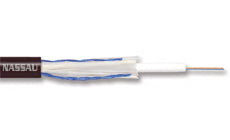Product Details
UG FTTP are all dielectric cables designed for Outside Plant (OSP) applications, specifically as a drop cable. The reduced diameter maximizes duct space and offers the lowest installed cost. The loose tube design offers reliable transmission performance over a broad temperature range. The single loose tube design features optical fibers placed inside a single PFM™ gel-filled tube. The core tube contains up to 12 optical fibers. The core tube is then helically wrapped with waterblocking strength members and encased with a black jacket. A rip cord is included to provide ease of access to the cable core.
Features:
• Available with up to 12-fiber
• Multiple fiber types including TeraFlex® bend resistant
• Dielectric outer strength members
• Highly flexible
• Small cable diameter
• Dry (SAP) core design
• PFM gel
Benefits:
• High fiber density
• Multiple network applications
• Eliminates grounding or bonding problems
• Easy handling
• Installation of more fibers in less space, reduced cost
• Reduces cable prep and installation time
• Non-sticky gel allows for easier and faster clean up
Specifications:
Fiber Count
• Available in 2-fiber up to 12-fiber
Standards Compliance
• Telcordia® GR-20-CORE
• RDUP PE-90 Designation 513
• RoHS-compliant
Environmental Specifications:
Operation/Storage
• -40°C to +70°C
Installation
• -30°C to +70°C
Applications:
• Drop cables
• Broadband network
• Local loop
• Fiber to the premise
| technical specification: | |
| fiber count | 4 |
| nominal diameter in (mm) | 0.26 (6.7) |
| approx. weight lbs/kft (kg/km) | 26 (38) |
| maximum tensile loading(install lbs (n)) | 300 (1,335) |
| maximum tensile loading(long term lbs (n)) | 100 (445) |
| minimum bend radius(install in (mm)) | 5.2 (132) |
| minimum bend radius(long term in (mm)) | 2.6 (66) |
| superior essex cable part number | 51004XX0Y |

